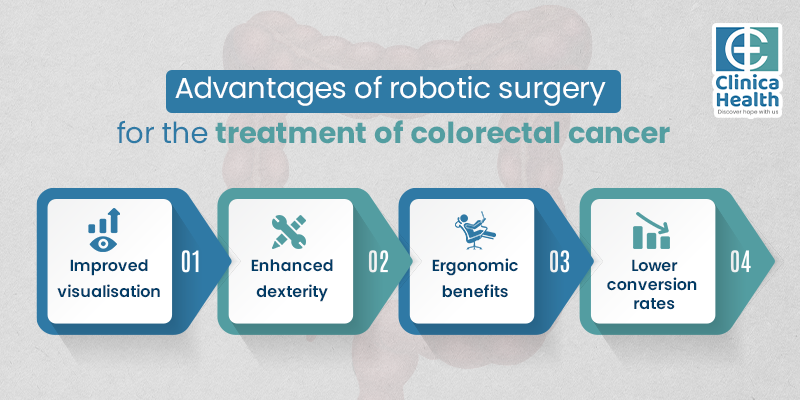The Role of Robotic Surgery in Rectal Cancer
Robotic surgery has greatly transformed the way cancer surgeries are performed, particularly rectal cancer surgery. This has led to improved treatment outcomes with fewer complications and faster recovery, which were previously thought to be unattainable.
Till now, rectal cancer surgery was performed by the open method, after which the laparoscopic procedure gained popularity due to its minimally invasive nature. However, with the advent of robotic-assisted technology, there is a new era in rectal cancer treatment, combining the minimally invasive nature of a laparoscopic procedure with precision and 3D visualisation.
In this blog, we will explore the role of robotic surgery and understand its benefits, challenges and comparison with conventional methods.
Understanding Rectal Cancer and Its Surgical Demand
Rectal cancer occurs when malignant cells start growing in the tissues of the rectum, the last portion of the large intestine just below the anus.
Rectal cancer is actually a form of colorectal cancer because both types share similarities in their risk factors and cell types. Previously, colorectal cancer was considered to affect only the older generation. However, its prevalence is rising among the younger individuals, too.
One of the risk factors for rectal cancer is definitely genetics, which means that a family history of the disease makes an individual more prone to developing the condition. Other causes include poor diet, unhealthy lifestyle and inflammatory bowel diseases.
Surgery is the most effective treatment for rectal cancer. However, surgical intervention comes with its own challenges. This is primarily because the rectum is situated in a narrow, confined space surrounded by nerves and blood vessels. The goal of rectal cancer surgery is not only to remove the cancerous cells but also to preserve the anal sphincter, surrounding nerves to maintain normal bowel, urinary and sexual function.
As a result, the demand for precision of rectal cancer surgical procedures has grown over the years to improve the quality of life. This growing change has led to innovations in surgical techniques, moving from traditional open surgery to minimally invasive laparoscopic approaches and now toward robotic-assisted surgery.
What is Robotic Surgery?
Robotic surgery is a form of minimally invasive surgery that uses advanced robotic systems to assist surgeons in performing complex procedures with enhanced precision, flexibility, and control.
As compared to traditional open surgery, which involves large incisions, robotic surgery involves small incisions through which surgical instruments and a high-definition 3D camera are inserted.
The most commonly used system is the da Vinci Surgical System, which consists of:
- A surgeon console, where the surgeon sits and controls the robot’s arms.
- A patient-side cart with robotic arms that hold surgical instruments.
- A high-definition 3D vision system that allows surgeons to control robotic instruments.
During the procedure, the surgeon manipulates the robotic arms using hand and foot controls, which translate the surgeon’s movements into real-time, precise actions inside the patient’s body. The robotic instruments have a greater range of motion than the human hand, allowing for greater dexterity in tight or delicate areas, such as the pelvis, making it especially valuable in rectal cancer surgery.
Advantages of Robotic Surgery for The Treatment of Colorectal Cancer
One of the major challenges that surgeons face while performing traditional rectal cancer surgery is the precise dissection in the narrow pelvic area to avoid damage to the nearby nerves. However, the main advantage of the robotic system is a 3D magnified view that allows the surgeons to view the tissues more clearly for more accurate treatment.
In robotic-assisted surgery, the instruments are equipped with articulated, wristed joints that provide seven degrees of freedom, closely mimicking the natural human hand but with greater precision. The robotic instruments can rotate, pivot and bend in ways that traditional tools cannot, which reduces technological challenges.
In traditional surgery, where surgeons are required to stand for long hours, robotic technology allows them to operate while seated at a console, which in turn reduces fatigue and enhances focus. This leads to improved performance, especially during complex and lengthy procedures.
Studies show that robotic surgery significantly reduces the need for conversion by offering clear visualisation, better access in tight spaces and better instrument control, resulting in better treatment outcomes.
Robotic Surgery Also Proves to be Beneficial for the Patients. Here are Some of the Benefits.
- Less pain: Being minimally invasive, robotic surgery is less painful. It involves smaller incisions and reduced trauma to the surrounding tissues, leading to a more comfortable stay.
- Faster recovery: Compared to open procedures, patients after robotic surgery can return to their normal activities within a few days.
- Reduced risk of complications: The precision of robotic surgery minimises damage to the healthy tissues, which, in a way, lowers the risk of complications and ensures proper wound care.

Are There Any Drawbacks Associated With Robotic Surgery?
Robotic technology in rectal cancer surgery also comes with certain drawbacks, which are as follows:
- Expensive: The procedure might be a bit expensive compared to conventional surgeries.
- Lack of tactile sensation: Robotic surgery solely relies on visual cues, and they do not provide any tactile feedback. If not operated properly, it can lead to tissue damage.
- Limited availability: Not all hospitals have the technology to carry out robotic procedures. Moreover, the availability of surgeons is also limited when it comes to performing robotic surgery.
- Not suitable for all: Robotic surgery might not be recommended for every patient. For example, individuals with anatomical anomalies or in complicated cases are not advised to undergo the procedure.
Conclusion
Robotic surgery for colorectal cancer is indeed a revolution in rectal cancer surgery. If you are diagnosed with rectal or colorectal cancer, consult Dr. Purnendu Bhowmik, a reputed cancer surgeon, for accurate treatment options for an increased survival chance.
 Call Now:
8010 552 552
7595 838 844
Call Now:
8010 552 552
7595 838 844
 Whatsapp Now:
8010 552 552
Whatsapp Now:
8010 552 552
 Email Me:
[email protected]
Email Me:
[email protected]

